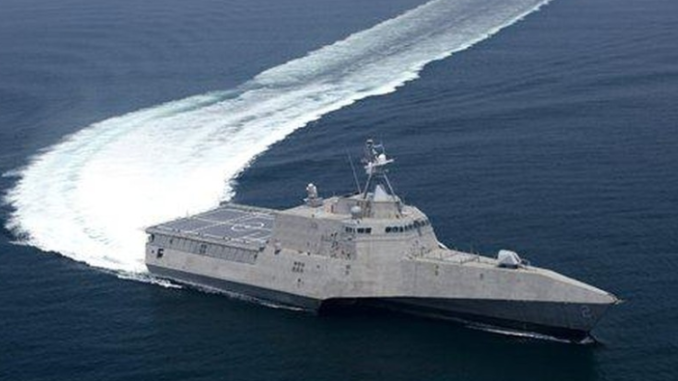
Biden is speaking loudly but carrying an ever smaller stick.
Over the past couple of years, Xi has been ratcheting up the pressure on Taiwan, and Biden has matched and raised his bet.
I have long been skeptical of the U.S.’ strategic ambiguity regarding Taiwan. Like it or not, Taiwan is now at the heart of global commerce, punching far above its weight class.
About 70% of microprocessors are made by Taiwan Semiconductor Manufacturing Company (TSMC), and while not all of them are manufactured on the island, the world economy would be crippled by its loss. Taiwan is at the heart of the high-tech economy upon which the world now depends, and that is one of the many reasons China wants to control it.
President Biden has, de facto, abandoned the decades-old policy of strategic ambiguity and declared that the US would defend the independence of the island from China, committing the US to war in the event of an attack. Taiwan, far more than Ukraine, is of vital strategic interest to us and it’s hard to fault him for buttressing deterrence.
Except it’s all talk. Biden is talking big but cutting the US Navy and strangling its budget. How, exactly, can we defend the country with an understrength Navy and a declining stockpile of ammunition? Every shipment to Ukraine that isn’t backfilled quickly diminishes our ability to actually defend the island.
Xi knows that. Biden claims that our support for Ukraine proves our commitment to our allies and will bolster deterrence. Perhaps so, except our actual military capabilities are shrinking by the day, and Biden is working to shrink them even faster.
The Washington Examiner has a story about our declining naval strength and Biden’s policies to cut the Navy further. It details how China’s navy is growing quickly, A Free Beacon story details how Biden’s budget shrinks the American Navy. It’s a one-two punch.
First, the Chinese buildup: in just 5 years the Chinese will have 150 more ships in its navy than we will. And China doesn’t have obligations all over the world, as we do.
Chinese naval forces will have about 150 more ships on the water than the U.S. Navy by 2028, according to Defense Department officials.
“By 2028, we will have approximately 291 ships or so,” U.S. Navy Secretary Carlos Del Toro told a Senate panel on Tuesday. “I can’t predict exactly what the Chinese will have, but estimates are upward of 440 or so.”
Hardly a trivial difference, wouldn’t you say? Even if we assume that the capabilities of each ship provide a distinct advantage ship for ship to the US, quantity has a quality all its own.
Modern naval warships are not built for survivability in the way older ships were. They have serious offensive capabilities, questionable defensive capabilities (they are theoretically very good, but untested in war), and with the exception of aircraft carriers very limited survivability if hit.
In a modern missile exchange, they will likely get hit. Each individual missile may have a modest shot at hitting, but a missile swarm certainly will, and China has missiles to spare. Our carriers may be survivable (there is lively debate), but destroyers? I wouldn’t bet on it.
So numbers matter, and we will be outgunned. I wouldn’t want to be on any Chinese ships, as they would likely go down too. We have missiles and aircraft as well, but numbers matter. And the US builds for quality, not quantity. We should build for both.
Del Toro provided that comparison as Navy and Marine Corps leaders pitched Congress on a $255.8 billion budget for fiscal 2024. They justified that number with a series of warnings about the centrality of naval power in the competition with China — “We find ourselves at an inflection point, one that demands we renew our commitment to naval primacy,” as Del Toro testified — but the officials acknowledged that President Joe Biden’s budget request doesn’t even keep up with inflation.
“No, it’s not,” Del Toro told the Senate Appropriations Committee. “I believe it’s about 2% below inflation.”
That estimate understated the gap between the budget and inflation , he added, clarifying that “2% below inflation” means 2% below the roughly 4.6% inflation rate that federal officials had predicted over the last two years.
“What’s the actual inflation rate?” Sen. Lindsey Graham (R-SC) asked.
“It’s somewhere in the 6% range,” Del Toro said. “Predictors are often wrong.”
That gap between inflation expectations and reality was thrown into stark relief by the portrait of Chinese Communist naval power conjured by the Navy’s top officer.
So…the navy is the key to our power projection in the Pacific for obvious reasons, but we are cutting the naval budget. While simultaneously committing to war.
Smart. The Free Beacon expands on the problem.
President Joe Biden’s 2024 budget proposal would deal a massive blow to the already strained American Navy—the White House wants to prematurely retire eight ships and two combat vessels. By taking these ships out of action, the Navy would lose more than 600 vertical launch missile systems—a missile capability that serves as the primary deterrent to Chinese military attacks in the Pacific, according to congressional research provided to the Washington Free Beacon.
“The Biden Administration’s defense budget would hollow out our fleet and scrap Navy radars and missile systems we desperately need to deter China,” Sen. Roger Wicker (R., Miss.), the Senate Armed Services Committee’s ranking member, told the Free Beacon. “Prematurely retiring our ships sends exactly the wrong signal to China as they continue to build their own Navy at a historic pace.”
Biden’s budget would decrease the total number of active Navy ships, retiring at least 11 ships while only requesting the construction of nine new vessels. The Navy currently has 294 battle force ships, far short of the 355 it is required to have by law. Biden’s budget would further reduce this number, according to information about the White House’s 2023 budget proposal codified by Wicker’s office.
How is this supposed to work? Have our navy “identify” as larger and more powerful than it is? Are we to wish capability into existence?
The White House’s budget proposal disregards repeated requests from the Marine Corps for a minimum of 31 amphibious warships—which would serve a critical role in any military conflict with China. Three of these ships are being retired, and the Biden administration is expected to order a “strategic pause” in the purchase of modernized warships, leaving the force below its statutory requirement of 31 ships.
Rebeccah Heinrichs, a national security analyst with the Hudson Institute think tank, said the Biden administration “seems to be under the illusion that the PRC will be deterred by strongly worded government reports and joint pressers with allies.”
If we intend to defend Taiwan the only strategy that makes sense is stopping the Chinese before they reach Taiwan’s shores. Any war over the island will be a naval war, and the Chinese are building the weapons platforms they need to win that war.
It’s possible they might not, but the betting would be that they might, and the costs to defend Taiwan would be devastating to all involved. Better to prevent the war by demonstrating the capability to win outright.
Biden doesn’t understand military affairs at all. He has demonstrated that throughout his career, being wrong on everything all the time. We can argue about Ukraine until the cows come home, but even if he is right to pour so much into the conflict he is bleeding dry our weapons caches to do it.
If we go to war with China, we will need those weapons. If you had to choose one war to win it would be Taiwan.
Congress simply must reject Biden’s naval budget. The alternative is to sleepwalk into a war we might lose.
* Article From: Hot Air

